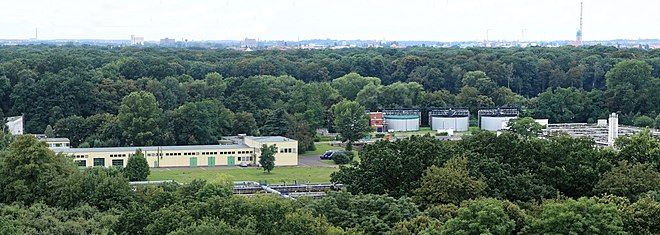Rosental sewage treatment plant
The Rosental sewage treatment plant is the main sewage treatment plant in the Saxon city of Leipzig . It is operated by the municipal waterworks Leipzig GmbH .
location
The Rosental sewage treatment plant is located at the north-western end of the Rosental park, which is part of the Leipzig riparian forest . Its area covers an area of about 25 hectares and is traversed by the White Elster . With an altitude of 103 m above sea level. NN it is one of the lowest lying parts of Leipzig, so that the wastewater mostly reaches the sewage treatment plant through a natural gradient. The sewage treatment plant is located at the end of a more than 2,800-kilometer network of sewers that feed both household wastewater and rainwater from the city; so it processes mixed water .
technology
Due to the proportion of rain in the mixed water, there can be strong fluctuations in the wastewater supply during rain events. In order to prevent the sewage treatment plant from being flooded, the sewer network has a so-called sewer network control, which makes it possible to temporarily store water in parts of the network and then gradually deliver it to the sewage treatment plant.
After reaching the wastewater treatment plant, the water passes through the computer and sand trap for mechanical cleaning , before the finer solids also settle on the bottom at a very low flow rate in the primary treatment .
After phosphate precipitation by adding an iron (III) chloride sulfate solution, which causes the phosphate to flocculate, microorganisms and bacteria in the activated sludge remove phosphorus, nitrogen and carbon from the wastewater for their biological purification of a total of 97,000 m³ in the flow with aeration Metabolism. The sludge settles in flakes in eight round secondary clarifiers with a total surface area of 16,992 m². The purified water is now discharged into the neighboring river Neue Luppe via a short pipe .
Part of the sludge is returned to biological treatment and the rest is broken down by microorganisms in digestion towers at 37 ° C to methane, carbon dioxide and water. The methane supplies electrical and thermal energy in a combined heat and power plant, which is used to operate the sewage treatment plant. The remaining sludge is dewatered mechanically and processed in a composting plant . The average amount of water cleaned per day is 110,000 m³.
history
In 1740, the first underground canal system was built in Leipzig after the sewage had previously drained into open trenches on the streets, except in septic tanks . A larger sewer system from 1833 led the untreated wastewater into the Leipzig rivers. Wastewater treatment in Leipzig only began in 1894 with the construction of the sewage treatment plant on the Rosental, and this has been continuously improved. In addition to the capacity expansion, the quality of the cleaning became increasingly important.
In 1978 the plant was completely modernized. In 2001, the construction of the sewer network control for the intermediate storage of excess mixed water, which had previously been discharged into the rivers after only mechanical cleaning, began. In 2012 this work was completed with the completion of the sixth steering structure. In 2007, the expansion of the biological wastewater treatment was completed.
After the connection of the Lindenthal and Wahren sewage treatment plants to the Rosental sewage treatment plant and the BMW plant as indirect dischargers and due to the steady population growth of the city, an expansion of the treatment capacity became necessary from 2017. By replacing or building a new mechanical stage with a hoist, rake, sand trap and primary treatment, as well as expanding or building the biological stage, the size of the building is to be expanded from 550,000 population equivalents to 710,000 population equivalents.
Other plants
In addition to their main sewage treatment plant in the Rosental, the Leipzig municipal waterworks also operate 25 other smaller sewage treatment plants, which mainly cover the area around Leipzig. The most important of these are those in Markkleeberg , Markranstädt , Taucha , Wiedemar and Knautnaundorf . The largest of them in Markkleeberg, however, has only about a twentieth of the capacity of the Rosental company.
literature
- Water supply and wastewater treatment Leipzig GmbH (Ed.): Rosental sewage works . Leipzig 1993
- Leipziger Wasserwerke: Our sewage treatment plants . June 2016, (Download) 6.8 MB
- Gabriele Zabel: The Leipzig sewage treatment plant Rosental . In wwt wasserwirtschaft wassertechnik , 5 (2008), pp. 10–16, (abstract)
Web links
- This is how wastewater treatment works in Leipzig. In: LVZ, April 4, 2017. Accessed July 7, 2019 .
- Visit to the Rosental sewage treatment plant. In: YouTube. Retrieved July 7, 2019 .
Individual evidence
- ^ The sewer network control of the city of Leipzig. Retrieved July 7, 2019 .
- ^ Expansion of the Leipzig Rosental sewage treatment plant. Retrieved July 7, 2019 .
- ↑ Flyer Our sewage treatment plants
Coordinates: 51 ° 21 '24.3 " N , 12 ° 20' 28.8" E


